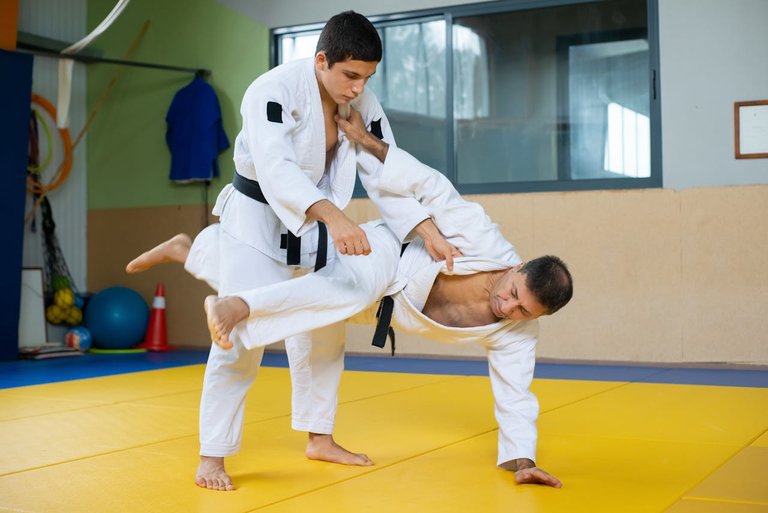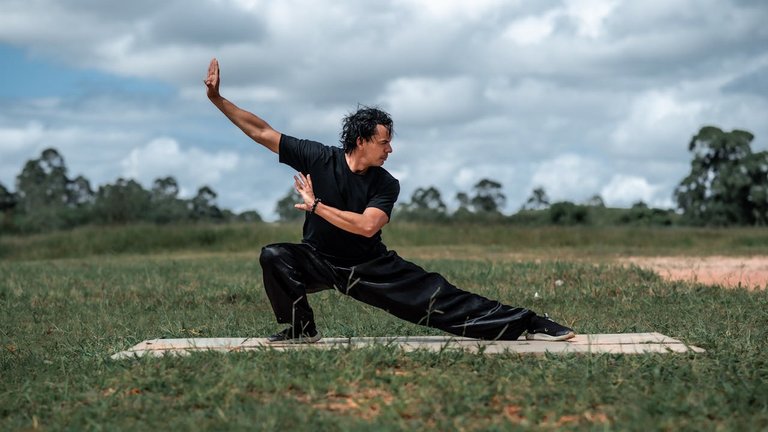Anyone who has been practicing martial arts long enough will likely spend some time cross-training in styles different than the one they started with. In this context, the martial art a person had started training, or has been training longest in, is considered their “base art.”
Cross-training typically is undertaken in an effort to add greater context or understanding to a base art. Sometimes the purpose is to shore up a perceived deficit within the base art. As a simple example of the later, taekwondo is considered a “stand up” martial art, and judo is considered a “grappling” martial art. Training both of them is considered to provide a more well rounded approach to fighting. But a person’s fighting style will likely be primarily informed by the one which they started first.

Image source: Pexels.com
I spent most of my martial arts training time with various styles of karate. Which style I practiced was a function primarily of geographic and economic availability. So, for simplicity, we’ll just say my “base art” is karate.
But a few years ago I made the conscious decision to shift my focus to tai chi, and to practice martial arts in the context of and with the understanding of body mechanics provided by tai chi.
Here’s why I did that.
When I first started learning tai chi, I was well into my career as a personal trainer. I had always had a passing interest in tai chi, since I knew many older karate practitioners who also cross-trained in tai chi. My understanding was that the slower, deliberate practice of tai chi helped to improve balance and precision with karate. Whether or not that’s correct is a topic for another time.
I started practicing tai chi as a result of my personal training career. I was due to earn some continuing education credits and re-certify with my certification agency. So I searched for a course that was interesting to me personally. That’s when I found the Tai Chi for Arthritis program, which was valid for continuing education credits. I figured that since it had to do with martial arts, and I had many older clients who would potentially benefit from tai chi as an exercise, that I should give it a shot.
I took the course, learned the form, and got my con-ed credits.
Shortly after that, I learned that a tai chi instructor was teaching that same program at a local library. Since I had only learned from the course DVD, I was eager to gain some insight and instruction from a more experienced instructor in person. I began taking classes with her, and began my tai chi journey in earnest.
Even though I was learning a health focused form that was heavily modified from the original Sun style tai chi form, I was able to begin connecting dots between tai chi movements and karate and ju-jutsu moves I was already familiar with. These connections added depth to all of these studies.
Soon enough I was teaching tai chi classes at the gym I owned and helping to stand in as an instructor when necessary for my own teacher’s classes. Tai chi became a significant part of my martial arts training, but karate was still my “base art.” It was my favorite.
So, why the change?
A number of things happened in a fairly short period of time that made me focus exclusively on tai chi for a while.
Covid Happened
Since I began my tai chi practice with a focus on exercise and increasing my class offerings at my gym, there was always a heavy emphasis on the well documented health benefits of tai chi practice. When Covid hit in early spring 2020, focusing on health was even more important.
As a gym owner, personal trainer, and martial arts instructor with many friends who were doctors and nurses I watched martial arts colleagues engage in dangerous behavior training in enclosed spaces without PPE, in spite of the recommendations to do otherwise. Working in health and wellness and having friends on the medical front lines meant that I took Covid very seriously. I took precautions to start coaching clients remotely before those were the official recommendations.
I watched so many martial arts instructors who would otherwise wax philosophical about the importance of solo practice or of personal protection rail so hard against the recommendations to do just that. Practice solo for a bit. Focus on personal protection. They did everything but, and the cognitive dissonance was deafening.
This lead to me having a sense of alienation with many martial arts practitioners I knew, most of them karate practitioners.
But there was an exception to all of this. Among tai chi practitioners, there seemed a greater willingness to switch to remote instruction. And when restrictions were lifted, it was tai chi people who seemed to maintain a sense of importance with safety, distancing, and PPE. Perhaps this is because there are so many tai chi people who also work in health and wellness. Perhaps it is because tai chi is often marketed as a health practice first and a martial art second. Either way, I took note and started associating more with tai chi people online. My personal practice time followed suit, becoming more and more dedicated to tai chi.

Image source: Pexels.com
Tai Chi is Less Hierarchical
What I’m about to say is not true for every tai chi or kung fu school, but it was my own experience. And that’s what we’re talking about here anyway.
As I was becoming more and more aware of some of the systemic problems inherent in running a business in a capitalist economy, and the opposing pulls of providing for clients and providing for the bank account, my views on business and society evolved.
Cooperation, and collaboration became far more important values to me than the competitiveness and cut throat money focused values of capitalism. When you start deconstructing things like that, a lot of other systemic things start falling apart in your world view.
One of these things is the safeguarding of information as an intellectual property. Another is the rigid, top down authoritarian structure of most martial arts schools. (Read about why I think the ideal martial arts school format is an anarchist collective.)
When you get to the point where you feel that intellectual property is not valid property and that ideas should be free to expand, evolve, and proliferate among people, the hierarchical curriculum and “close guarded secrets” of a martial art become difficult to uphold. And it becomes difficult to put yourself in an environment where that kind of limited thinking is the norm.
So, I had another reason to stop training in environments where “tradition” dictated a uniform way of doing things and learning.
And once again, I noticed far less of this among tai chi people. My own tai chi circle did not use such trappings as uniforms and belt ranks to force conformity. The environment was friendlier, and more open to collaborative exploration of tai chi rather than rote learning.
Here again, I had another reason to continue to focus on practicing tai chi over all of the other things I was practicing at the time.
By now, I had had it up to here with karate people and spent the next few years exclusively practicing tai chi.
Now, as I’m planning on adding karate back in to my training, it is in the context of tai chi being my base art, where previously it was the other way around.
Many people add tai chi to their karate to get better at balance or mindfulness. Some add it to go easy on their joints as they age. These are all valid.
I’m focusing on tai chi because I have found the art to be deep and healthy. There are plenty of valuable fighting concepts present in the art. There are abundant health benefits to tai chi practice. But more importantly, the tai chi community at large is more aligned with my evolving values. It now forms the base of my training, and anything cross-trained exists within the context of those values.